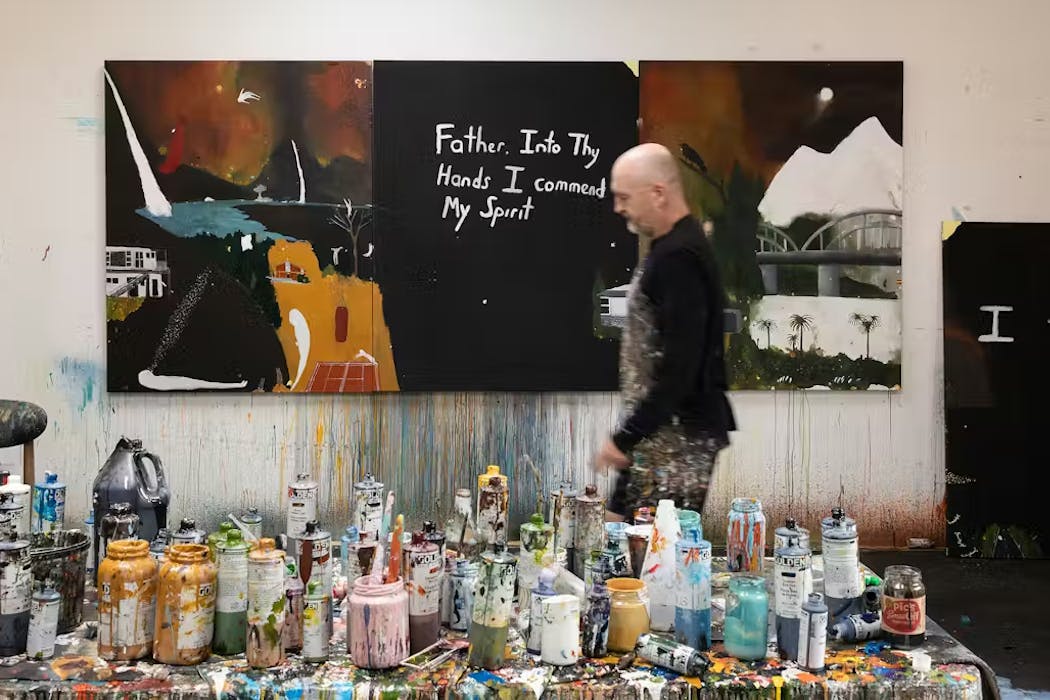
On Saturday, I saw a man genuflecting at the traffic lights on Smith Street, in Melbourne’s suburb of Collingwood. It was a sign: confirmation of artist Richard Lewer’s conviction that some of us still reach out to God in times of need – and convenience.
I Only Talk to God When I Want Something is the title of Lewer’s new exhibition at Geelong Gallery. Curator and assistant director Lisa Sullivan brings together paintings, drawing, and pegboard confessions (painted live as part of the National Gallery of Victoria’s last Triennial) in this mini survey focused exclusively on Lewer’s religious works.
The exhibition was catalysed by the artist’s gifting of the Confession series to Geelong Gallery – no doubt an acknowledgement of his longstanding relationship with the gallery that began in 2008.
The early years
Lewer was born in Hamilton, Aotearoa New Zealand, in 1970. He has lived on both sides of the Tasman Sea, and both sides of Australia, in Auckland/Tāmaki Makaurau, Melbourne/Naarm and Fremantle/Walyalup.
The earliest works in the exhibition include a densely layered charcoal drawing of his childhood church, St. Pius X, in Hamilton. It was here Lewer made his first confession. Separated from the priest by a pegboard screen, he would share his anxieties and misdemeanours – the abiding subjects of his 30-year career.
Lewer has often confessed drawing has saved his life. If this is the case, then surfing nearly ended it. At the age of 18, he had a near-death experience while surfing in Raglan, west of Hamilton.
A litany of confessions
In the smaller of the two galleries across which Lewer’s exhibition is spread, a selection of Confessions face the 14 Stations of the Cross.

Confessions such as I Told My Partner I Wanted Kids But I Didn’t, and I Just Don’t Get Art (also available from the gallery shop as a t-shirt) are painted onto yellow, black, white and brown masonite pegboard.

These juxtapose the depictions of Jesus’ final moments in the Stations of the Cross – an endurance test played out by a cast of fleshy pink figures.

Often placed within the church or the landscape as sites of pilgrimage, the Stations of the Cross invite Christians to see themselves in God’s suffering.
It’s at this point I am reminded of my own adolescence, whereby sports lessons often involved running across a stark Hunter Valley hillside, from one simulated Station of the Cross to the next, beseeched by the clergy in an act of everyday evangelism.
Experience into art
As a young Catholic, Lewer was exposed to the idea of transubstantiation – the conversion of one thing into another, whereby the everyday would become miraculous. Think bread and wine into body and blood.
Lewer practices transubstantiation in his artmaking. Sheets of metal, unprimed canvas and discarded op-shop paintings are transformed into everyday allegories including The Seven Deadly Sins, The Last Judgement and Stations of the Cross. The first work I ever saw of Lewer’s was painted on billiard table felt. I knew then that he could work miracles.
The new painting, titled Last Supper at the back of the Geelong Gallery, is one such miracle. The foreground of the painting hosts Christ’s last meal while the gallery’s resident royal, George V, is flanked by two of Lewer’s Stations of the Cross in the background.

All the while the good citizens of Geelong, who occupy “the middle ground”, go about their business with a level of nonchalance last seen in a Bruegel painting.
Lewer’s 2025 six-panelled painting The Last Judgement is a heavy hitter. “You only get one shot at the last judgement,” he comments wryly when I quiz him about this work.
Commencing with a white crucifix on a black ground – an homage to New Zealand artist Colin McCahon – each painted panel bleeds into the next, foretelling the next stage of salvation.

Here is hope and dread in equal measure. Lewer’s entire trans-Tasman life is condensed across the six panels: the Hamilton church, the patterned carpet from his childhood home, the punching bag from days in the boxing ring and vestiges of landscape from time spent in the Kimberley, Western Australia.
All are watched over by the avian spirit guardian tūī while the dead, represented as floating white apparitions, rise towards heaven.

It was Lewer who once told me that every exhibition has an outlier – a work that pulls away from the rest and reaches into the unknown – into the next chapter, still inchoate in the mind of the artist and their audience. And to make a work like that, you gotta have faith.
I Only Talk to God When I Want Something runs until March 1 2026.
This article is republished from The Conversation, a nonprofit, independent news organization bringing you facts and trustworthy analysis to help you make sense of our complex world. It was written by: Lisa Slade, The University of Melbourne
Read more:
- US-Nigeria relations: what it means to be a ‘country of particular concern’ and why it matters
- Healing, purification and holiness: how ancient Greeks, Romans and early Christians used olive oil
- The Land Sings Back: a gorgeous exhibition of drawings inspired by ecofeminism
Lisa Slade does not work for, consult, own shares in or receive funding from any company or organisation that would benefit from this article, and has disclosed no relevant affiliations beyond their academic appointment.


 The Conversation
The Conversation
 KLCC
KLCC CNN Politics
CNN Politics Mashable Entertainment
Mashable Entertainment